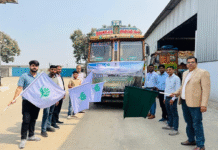
Some good news and something to be concerned about. The alarming news first. Many may believe climate change is a hoax. But it doesn’t take an expert to analyze, observe, and realize how sudden changes in weather and climate, which are even taking scientists by surprise, are becoming all the more common. Intense spells of rain within a short period, long patches of dry weather, rising global temperatures, and severe cold waves no longer surprise us.
All these have a severe bearing on our lives – and food security. Climate change and adverse weather take a heavy toll on agriculture. And that’s where our food primarily comes from.
According to a recent report by the Food and Agriculture Organization (FAO), inclement weather affecting key producing countries such as Brazil and Vietnam has played a key role in driving world coffee prices to a multi-year high in 2024 – increasing 38.8% on the previous year’s average. India’s coffee-producing regions along the Ghats and southern India have also been hit by spells of heavy rain.

And it is not just coffee. If heat waves in India’s northwestern and central regions coinciding with the wheat harvest season hit wheat production in 2022 and even later, late rains have also consistently affected rice sowing, forcing farmers to shift the sowing season or look for alternatives such as millet at the last moment.
A recent report by the US Environmental Protection Agency explains how climate change has a negative bearing on agricultural productivity, impacts soil and water resources, hits agricultural workers’ health, and directly affects the economy and food security. Though the report closely looks at the state of US farming, the circumstances wouldn’t be much different in India.
In India, an agriculture-driven economy, where the entire industry waits for a good monsoon forecast, one can well imagine how adverse weather affects millions of smallholder farmers whose entire year depends on a decent harvest.
FAO’s ‘The Unjust Climate’ report released last year shows poor households globally lose 5% of their income due to heat stress and 4.4% due to floods annually, compared to better-off households. The rural poor in India suffer reduced off-farm employment opportunities during droughts, forcing them to allocate more resources to agriculture.
Households headed by women in rural areas suffer significantly greater financial losses than those headed by men.
Each year, in low- and middle-income countries, on average, female-headed households lose 8% more of their income due to heat stress and 3% more due to floods compared to male-headed households. This translates to a per capita reduction of US$83 due to heat stress and US$ 35 due to floods, totaling US$37 billion and US$16 billion, respectively, across all countries.
The report suggests targeted interventions to empower various rural populations to engage in climate-adaptive measures. It recommends scaling up financial support programs ahead of extreme weather events, investing in skills development and vocational training to help rural poor households diversify from climate-sensitive work, tackling discriminatory gender norms to prevent women from participating in non-farm employment, encouraging group-based approaches to agricultural experimentation to help rural farmers adapt to changing climate and public investment in promoting climate-resilient agricultural technologies.
As summer approaches and all eyes on ears are on the Met department’s long-term forecast, such interventions would certainly help. This February, for the record, was the warmest in India since 1901. March, April and May, when summer peaks, are also likely to be warmer than normal, the Met office says. All the more reason to be concerned.
Crop estimates positive
All is not lost yet on the farm front. The second advance estimates of the production of major agricultural crops (kharif & rabi) for 2024-25 (July to June), released by the Ministry of agriculture and farmers’ welfare, says record production of rice, wheat, maize, groundnut and soybean has been achieved.
The government expects a total Kharif food grains production of 166.39 million tons and 164.52 million tons during the Rabi season (excluding summer). Kharif rice production is expected to hit a record 120.67 million tons and Rabi rice (excluding Summer) is forecast at 15.75 million tons. It forecasts a record-high 115.43 million tons of wheat production compared to 113.29 million tons last season.
While the government’s estimates smell of optimism and are good news for the country’s food security, there is no denying that climate change and highly unpredictable weather are real and will only get worse. While tackling climate change is a long-term process, the immediate need is climate adaptability and climate-resilient and climate-smart farming methods that maximize the use of tech.
IndiFoodBev — authentic, impactful and influential
An English-language food and beverage processing and packaging industry B2B platform in print and web, IndiFoodBev is in its third year of publication. It is said that the Indian food and beverage industries represent approximately US$ 900 billion in revenues which implies more than 20% of the country’s GDP. Eliminating the wastage on the farmside can help to deliver more protein to a higher number of the population apart from generating sizable exports. The savings in soil, seeds, water, fertilizer, energy and ultimately food and nutrition could be the most immense contribution that country is poised to make to the moderation of climate change.
To improve your marketing and grow sales to the food and beverage processing and packaging industry, talk to us. Our research and consulting company IppStar [www.ippstar.org] can assess your potential and addressable markets in light of the competition. We can discuss marketing, communication, and sales strategies for market entry and growth.
Suppliers and service providers with a strategy and budget for targeted marketing can discuss using our hybrid print, web, video, and social media channels to create brand recognition linked to market relevance. Our technical writers are ready to meet you and your customers for content.
The second largest producer of fruit and vegetables in the world is continuously expanding processing capacities and delivery systems with appropriate innovative technologies. We cover product and consumer trends, nutrition, processing, research, equipment and packaging from farm to thali. Get our 2025 media kit and recalibrate your role in this dynamic market. Enhance your visibility and relevance to existing markets and turn potential customers into conversations. Ask for a sample copy of our bi-monthly in print or our weekly IndiFoodBev eZine each Wednesday.
For editorial info@ippgroup.in — for advertisement ads1@ippgroup.in and for subscriptions subscription@ippgroup.in
Naresh Khanna – 10 February 2025
Subscribe Now











